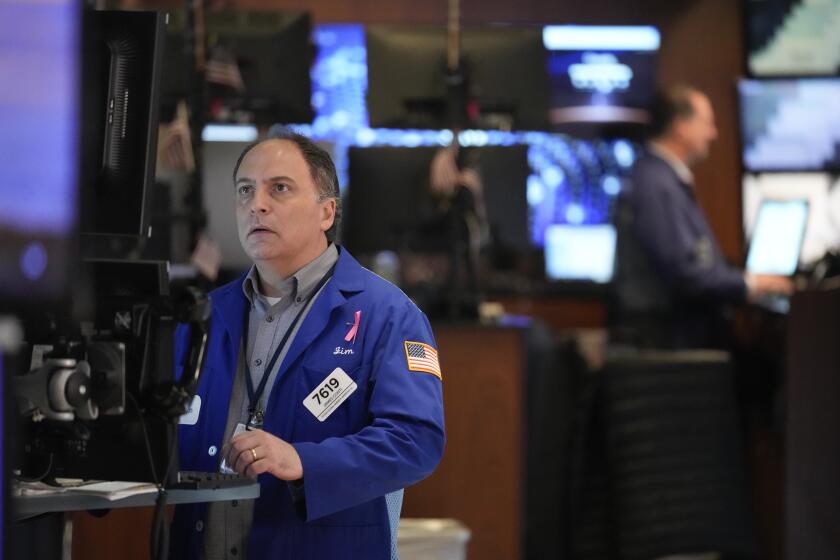Dollar, Even in Decline, Makes World Go Round
To hear some comments about the plunging value of the dollar, you’d think the U.S. economy was a collection of scrap assets up for sale on EBay.
Last week, the greenback kept falling against the European euro and the Japanese yen. There was a lift when news broke of the capture of Saddam Hussein by U.S. soldiers, and then it went south again.
In the last year, the American currency has declined 15% against the euro, so that it now takes about $1.24 to buy one of the European notes.
The reason this is happening, according to some experts, is simple: International investors are worried about what’s called the current account deficit -- the difference between the value of goods and services that the U.S. imports and exports, plus the difference between what the U.S. pays foreigners in interest and dividends and what foreigners pay the U.S.
The current account deficit is, in fact, enormous. It will hit about $450 billion this year, which means that the U.S. must attract foreign investment at the rate of about $1.5 billion a day to stay even. Of course, that makes it sound as if Washington has mortgaged itself to the point that a creditor from Europe or Asia could foreclose on the White House and every other government building up and down Pennsylvania Avenue.
But that is not what these numbers really mean.
The current account deficit is actually reflective of a positive trend. It’s the greatest example of how the “U.S. has globalized its economy largely to benefit the rest of the world,” says Edward Yardeni, chief investment strategist at Prudential Equity Group.
Indeed, the U.S. is the key to the health of the international economy, taking in goods and services from across the globe and paying out dollars in return. Far from being an uncompetitive slouch, the U.S. has expanded its exports almost 6% a year since 1990. At the same time, it has expanded its imports 8.8% a year.
Some of the dollars that land overseas -- especially in China, Japan, Taiwan and South Korea -- are then reinvested in U.S. Treasury bonds and in U.S. corporate securities.
That helps those countries build up reserves, enabling them to develop their economies. For example, China expanded its internal money supply 20% last year, disbursing the capital to erect highways and factories, dams and office buildings. In turn, Yardeni points out, China’s rapid development helped European construction companies get more work than they could back home.
The greenback, in other words, is the grease that makes the global wheel turn. For that reason, the dollar is not about to undergo a total collapse.
Central banks in Asia hold $1.6 trillion of Treasury securities and other dollar assets. And they’re “not about to shift out” of them, says Kenneth Courtis, Tokyo-based vice chairman of Goldman Sachs Asia. For one thing, some of their own currencies are pegged to the dollar. For another, some countries have complex political and financial alliances with the U.S.
So they keep buying U.S. Treasuries -- conferring a benefit on all Americans because U.S. interest rates remain lower than they otherwise would.
Meanwhile, the weak dollar has its upsides. In the classic sense, a frail currency helps U.S. exports by effectively lowering their price to foreign buyers. U.S. agricultural exports -- particularly of cattle and meat -- have done well this year. So have California exports of fruits, vegetables and nuts.
What’s more, more than 40% of the profit posted by companies in the S&P; 500 is generated abroad, notes Chris Ordorff of Los Angeles investment firm Payden & Rygel. When the dollar goes down, those earnings look all the more strong. This underscores that much of the trade balance is not a measure of competitiveness among nations. Almost half of all the movement of goods and services today consists of internal transfers by multinational companies, most of them U.S.-owned.
Does all this mean that the current account deficit can keep climbing -- and the dollar falling -- without us ever having to worry? No. In the long run, the world economy needs a better sense of balance. If imports to the U.S. were to keep soaring, inflation would become a problem. More countries, especially Japan and those of Europe, need their economies to grow faster, providing a richer market for U.S. goods and services.
“The U.S. economy has served as the engine for a decade,” says economist Joseph Quinlan of Bank of America. “It needs other countries to develop their consumer markets, too.”
How long the dollar will remain weak is far from clear. Many predict that as the U.S. economy continues to heat up, the Federal Reserve will have no choice but to raise interest rates. And that will spur the dollar higher, attracting investors who are now seizing on Europe’s relatively lofty rates.
In the meantime, though, don’t let all this chatter about a low dollar spook you. Ignore the scare talk. The greenback’s fall speaks to America’s strengths as much as its weaknesses.
*
James Flanigan can be reached at jim.flanigan@ latimes.com.






